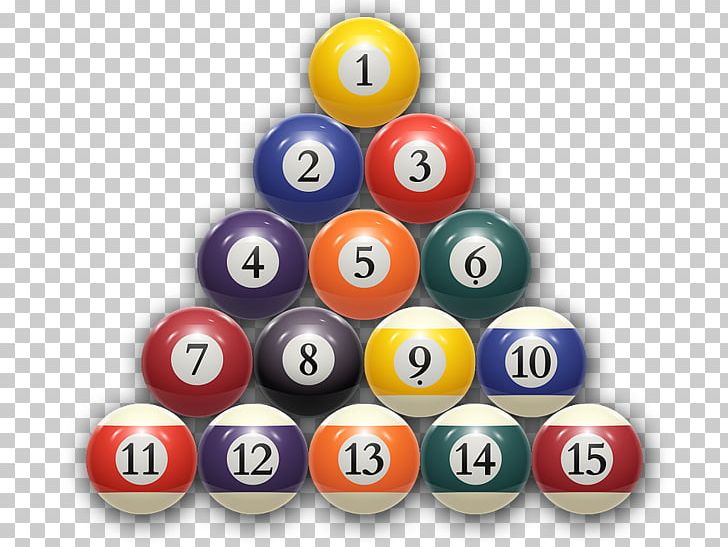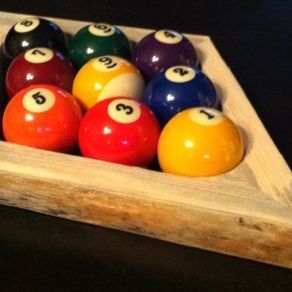

Note: Balls are to be randomly placed in the rack with a solid and a strip on each corner. The base of the rack should be parallel to the foot cushion. The object balls (1-ball through 15-ball) are to be racked as tightly as possible in a triangular shape with balls randomly placed in the rack with any stripe or solid at the apex of the triangle and on the foot spot, the 8-ball in the middle of the triangle, a striped ball in one corner of the rack and a solid ball in the other corner. Any ball pocketed on a foul remains pocketed, regardless of whether they belong to the shooter or the opponent. When calling your pocket, it is never necessary to indicate details such as the number of cushions, banks, kisses, caroms, etc. If the shooter does not call their intended object ball and pocket when performing a bank shot, a kick shot, a jump shot, a masse shot or a combo shot, it is a loss of turn.

Obvious balls and their respective pockets do not have to be specified, however, when performing a bank shot, a kick shot, a jump shot, a masse shot or a combo shot, the shooter must call their intended object ball and pocket. It is encouraged that all balls be specified vocally to your opponent along with their intended pocket. If the two players agree to play “call your pocket” then the following rules apply:Ĭalling a pocket is done by either, verbally announcing the designated pocket to the opponent or any shooter on the opposing team or by pointing at the pocket with your hand or pool cue. If the players can’t agree to “call your pocket” then the players will play the set as “slop counts”. Pocketing the 8-ball in the wrong pocket (different than the called pocket) or on any stroke before your set is cleared is an immediate loss of game.In the Leisure format, at the start of a set the two players must agree to play “call your pocket”. (This unusual rule was set to end long defensive struggles where players were afraid to disturb an 8-ball close to a pocket.) Technically a player could use their turn to push an opponent's ball straight into a pocket!īCA rules, which pave the way for enjoyable play, stipulate that a scratch on the 8-ball is not a loss of game unless the 8-ball pockets on the same shot.

With ball-in-hand one measure designed to speed play, a second is that object balls illegally pocketed stay down and are not returned to the table. Failure to strike your set first (or striking one cleanly followed by subsequent failure to drive at least one ball into a pocket or rail) yields ball-in-hand to your opponent.īall-in-hand is awarded following any cue scratch. Once your set is determined, you must "play clean" hitting an object ball, one of the balls from your set of stripes or solids, first on any subsequent stroke. Even if you've sunk three solids and no stripes, you must make a called shot after the break to ensure solids. The fairest way to proceed is to have an open table despite what has been pocketed. Your turn continues if a ball is pocketed on the break. Although it is debatable whether breaking 8-Ball hard (or breaking at all!) is a wise idea. To begin the game, make an open break, smashing the balls apart. Referees who have many 8- or 9-balls sink in those games will come under scrutiny for improper racking!**Ĭalling pockets for individual billiards shots where local 8-Ball rules allow adds flexibility - whether a ball goes straight into the pocket, zooms around before sinking or flies through the air to the hole like a basketball to the hoop, you retain your turn. The opponent should always rack tightly in all games, but a tight rack helps ensure that the 8-ball wouldn't move much on the snap. And it should be a win - it means you risked breaking the balls hard enough to scatter the 8-ball also.īut where your local rules state sinking the eight is a loss, make sure your opponent racks tightly. In many places, the eight on the break is a win. Do you lose or win if it is pocketed on the break? Some local "rule books" say it's a loss but many disagree with this mess. **A lot of arguments are created over sinking the 8-ball on the break. Your objective as expanded upon in "official" 8-Ball rules, (whichever league, tournament or local rules are used) is to pocket your set of object balls numbered 1 through 7 ("lows" or "solids") or 9 through 15 ("highs" or "stripes") before pocketing the 8-ball on a called shot.


 0 kommentar(er)
0 kommentar(er)
